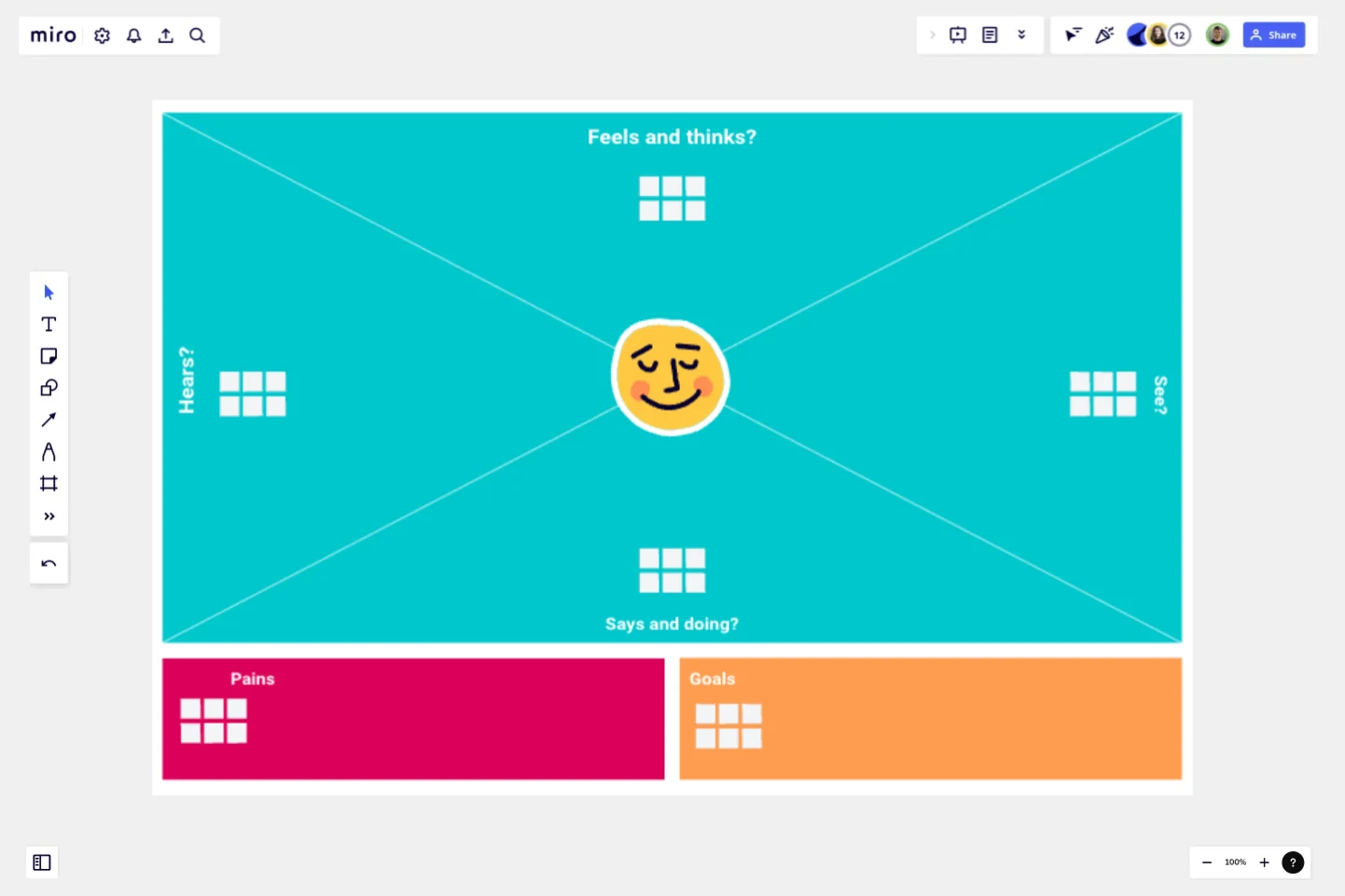Empathy Map by Medicenjuande
The Empathy Map is a tool that allows us to get to know our users or user models, connecting with their way of thinking, the influence they receive in their environment, and the content and opinions they hear and watch.
As well as all those actions that will require effort and, in some way, pain when carrying out activities, as well as the actions that represent success and the fulfillment of certain goals.
How living the experience with this template:
Feels and thinks
In this space, we put all the data about what our user feels and thinks.Their emotions and feelings are essential for the assembly of the user persona.We can obtain this information from surveys, observations, or interviews.
See
In this space, we are going to describe the way in which our person observes the world, the information he consumes, and the reality that surrounds him. For example, if he lives in a country in crisis, his day-to-day what he sees will not be the same as if he lived in a stable country.
Says and doing
Here we write what our person says and does. For example, if he has an ecological and responsible discourse, he is likely to do social work, compost or recycle in an excellent way.So what he says always conditions what he does.
Hears
Here we are going to describe what the person listens to, which people he follows, who inspires him, for example, Podcasts, Newscasts, etc.
Pains
Efforts, pain, events, or conditions that cause suffering or generate a negative impact on our person.
Goals
Here we will describe what goals, objectives, or dreams our person wants to fulfill.Thanks and regards!
This template was created by medicenjuande.
Get started with this template right now.
Creative Brief Template
Works best for:
Design, Marketing, Desk Research
Even creative thinkers (or maybe especially creative thinkers) need clear guidelines to push their ideas in productive, usable directions. And a good creative lays down those guidelines, with information that includes target audience, goals, timeline, and budget, as well as the scope and specifications of the project itself. The foundation of any marketing or advertising campaign, a creative brief is the first step in building websites, videos, ads, banners, and much more. The brief is generally prepared before kicking off a project, and this template will make it easy.
Customer Journey Map by Columbia Road
Works best for:
Customer Journey Map
The aim of the customer journey is to help you break down the customer's activities from both a front-end and back-end perspective.
Service Blueprint Template
Works best for:
Desk Research, Operations, Market Research
The Service Blueprint template is a visual tool for designing and optimizing service experiences. It provides a structured framework for mapping customer journeys, identifying touchpoints, and aligning internal processes. This template enables teams to visualize the entire service ecosystem, uncover pain points, and innovate solutions to enhance customer satisfaction. By promoting customer-centricity and collaboration, the Service Blueprint empowers organizations to deliver exceptional service experiences and drive sustainable growth.
Service Blueprinting Workshop
Works best for:
Agile
The Service Blueprinting Workshop template helps teams visualize and improve service processes. It includes ice breakers, context canvas, empathy maps, and action plans for service transitions. Use it to align teams, identify opportunities, and prototype service delivery from a macro to microscopic level, ensuring a comprehensive understanding of service orchestration and seamless collaboration. Ideal for remote and dispersed teams.
Mind Map Template
Works best for:
Design
Based on Joseph Novak's innovation, Concept Mapping, this template helps to organize ideas and demonstrate a comprehensive understanding of a subject. It visually arranges all the details about a topic, which fosters shared understanding. This technique is particularly useful when explaining different facets or related topics.
Empathy Map by Lucie Agolini
Works best for:
Research & Design, Market Research
The Empathy Map template offers a straightforward way to visualize user insights. By focusing on what users think, feel, say, and do, you can develop a deeper understanding of their needs. This template is perfect for improving user experiences and driving customer satisfaction.
